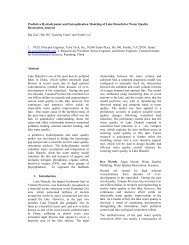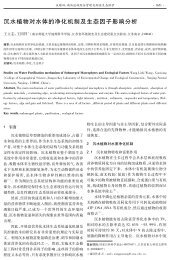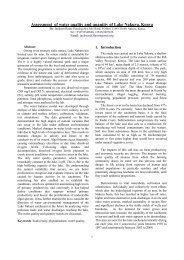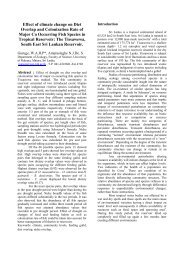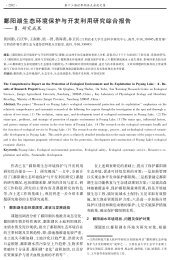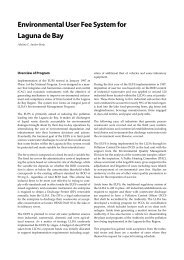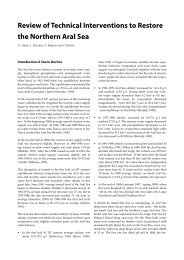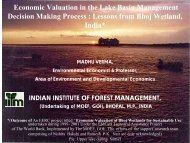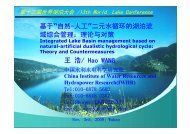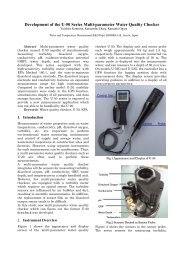Renuka Lake ecosystem and wetland protection, Lesser Himalaya ...
Renuka Lake ecosystem and wetland protection, Lesser Himalaya ...
Renuka Lake ecosystem and wetland protection, Lesser Himalaya ...
Create successful ePaper yourself
Turn your PDF publications into a flip-book with our unique Google optimized e-Paper software.
<strong>Renuka</strong> <strong>Lake</strong> <strong>ecosystem</strong> <strong>and</strong> wetl<strong>and</strong> <strong>protection</strong>, <strong>Lesser</strong> <strong>Himalaya</strong>,Himachal Pradesh, IndiaDAS Brijraj.KGeology of Department, Panjab University, Ch<strong>and</strong>igarh-160014(India)E.Mail:bkdgeochem@yahoo.inAbstract The oval-shaped <strong>Renuka</strong> <strong>Lake</strong> islocated at an elevation of 620m above mslin Himachal Pradesh. The lake follows ariparian course between steep hill slopes onboth the sides with thick forest. The lake isalkaline, Ca 2+ + Mg 2+ are the major cations<strong>and</strong> HCO 3 - <strong>and</strong> SO 42-are the major anions.The high SO 4 2- in the lake water is derivedfrom black carbonaceous shale <strong>and</strong> gypsumof the lithology. The total hardness of lakewater exceeds the prescribed limits henceunfit for drinking, washing, <strong>and</strong> agriculture.The Na, K, <strong>and</strong> Cl are deficient in <strong>Renuka</strong><strong>Lake</strong>. The variation in the chemistry of thelake water is primarily due toanthropogenic activity <strong>and</strong> the ripariancourse of lake. The drop of trashes by thetourists <strong>and</strong> seepage of inlets of domestic<strong>and</strong> municipal sewage has resulted in thegrowth of the macrophytes particularly inthe extreme west of <strong>Renuka</strong> <strong>Lake</strong> wheretourist lodge, temples <strong>and</strong> bathing ghats arelocated. The growth of weeds causesdeficiency of D.O leading to eutrophicconditions <strong>and</strong> consequent fish mortality inthe lake. The lake water in contact with soilin the riparian zone show variation in somemajor <strong>and</strong> trace elements. The vegetation inriparian zone affect both the quantity <strong>and</strong>quality of water. The wetl<strong>and</strong> sedimentchemistry shows enrichment in Al 2 O 3 ,Fe 2 O 3 , K 2 O,TiO 2 <strong>and</strong> trace elements Y, Zr,Ni, Th, U <strong>and</strong> Nb compared to lakesediments <strong>and</strong> the latter shows similaritywith Post Archean Australian shale(PAAS)indicating higher clay fraction in wetl<strong>and</strong>.Therefore, the variation in water chemistryof riparian zone is soil controlled. Thehigher Zr/Hf ratio of lake sediments <strong>and</strong>wetl<strong>and</strong> suggests that these elements arecontrolled by zircon. The higher Zr/Yb <strong>and</strong>Zr/Th ratios in wetl<strong>and</strong> sediments comparedto lake sediments show mineral sorting(fractionation) during process of lighterparticles (clays) being trapped in thewetl<strong>and</strong> soil concentrating heavy mineralsin sediments. This shows wetl<strong>and</strong> control inthe flow of nutrients <strong>and</strong> metal ions in thelake basin. The removal of plant cover, roadconstruction <strong>and</strong> widening have acceleratedsilting in lake (3.3mm/yr).In order to reducesilt flow dredging has been carried outsuccessfully in the wetl<strong>and</strong>.Key words Alkaline, Dredging, HimachalPradesh, <strong>Renuka</strong> <strong>Lake</strong>, Riparian course,Soil control.1.IntroductionThe lake <strong>ecosystem</strong> is disturbed byvarious factors such as natural <strong>and</strong> manmade. The natural factors may includeclimate, acid rain, nuclear fall out, l<strong>and</strong>slide, etc. But impact of man made factors,in most of the fresh water lakes, arepronounce <strong>and</strong> detrimental. Discharge ofpollutants from point <strong>and</strong> non-point source,deforestation, extensive cultivation,building construction, road construction<strong>and</strong> widening, setting of industries,discharge of untreated effluents, domesticsievage etc. not only pollutes the waterbody but also causes increased silt flow inthe lake basin making it shallow hencecutting short the life span of the lake.The Riparian zones have the capacity tobuffer surface water bodies from non-pointsource run off from agriculture, urban or1
other l<strong>and</strong> uses. It even absorbs sediment,chemical nutrients <strong>and</strong> other substances innon-point source run off. Riparian zones areinstrumental in water quality improvementfor both surface <strong>and</strong> water flowing intowater bodies through sub-surface or groundwater flow. The wetl<strong>and</strong> riparian zonesshows a particularly high rate of removal ofnitrate entering a stream <strong>and</strong> thus has aplace in eutrophication management.Because of there prominent role insupporting a diversity of species, riparianzones wetl<strong>and</strong> are often the subject ofnational <strong>protection</strong> in a Biodiversity ActionPlan.<strong>Renuka</strong> <strong>Lake</strong> having a riparian course<strong>and</strong> a wetl<strong>and</strong> shows water quality control,soil conservation, their biodiversity <strong>and</strong>influence on aquatic <strong>ecosystem</strong>. Toestablish these characters a comprehensivestudy of water quality, lake <strong>and</strong> wetl<strong>and</strong>sediment geochemistry, isotope chemistryto determine rate of sedimentation, <strong>and</strong>survey of flora <strong>and</strong> fauna distribution havebeen carried out. The lake is unique inlesser <strong>Himalaya</strong> <strong>and</strong> is under RamsarConvention Environment Act.2. MethodologyThe water samples were collected in prewashed1L polythelene bottles filling it tothe capacity. Within 5-6 hours of collectionpH, E.C, D.O, TDS etc. were measuredusing portable field kit. The samples werefiltered using 0.45 µm Millipore filtermembranes. A part of this was used formeasurement of carbonate <strong>and</strong> bi-carbonateby acid titration, choride by AgNO 3titration, sulphate by Ba(ClO 4 ) 2 titrationafter passing the samples through cationexchange resin, phosphate by an ascorbicacid spectrophotometry, silicate bymolybdenum blue spectrometry. Na, K byflame photometer <strong>and</strong> Ca <strong>and</strong> Mg by AAS2100(Perkin Elmer Atomic AbsorptionSpectrophotometer).The sediment samples carefully selectedwere collected from lake <strong>and</strong> wetl<strong>and</strong>, dried<strong>and</strong> processed. The samples were ground to-200 mesh size in agate mortar <strong>and</strong> wereused for making pellets. These pellets weresubjected to X-ray fluorescencespectrophotometer (energy dispersive,Phillips EXAM-6 system) <strong>and</strong> major <strong>and</strong>trace elements were estimated. Theaccuracy was checked by running USGSsediment st<strong>and</strong>ards SDO1, SCO1, GSD9<strong>and</strong> SO1. The major element accuracy is~2.5%. The REE’s were measured on ICP-MS using G2 <strong>and</strong> SDO1 st<strong>and</strong>ards in theUniversity of Kiel, Germany. As the REE.sare present in minor quantities in the matrixelements, therefore, elements have to beseparated as a group so that the spectralinterference from the matrix elements canbe avoided. The precision of data is betterthan 5% except for Ce <strong>and</strong> Nd, which haveprecision of about 10% <strong>and</strong> for REE(
The average rain fall in the region isbetween 150-199.9 cm per annum (Joshi,1984) 1 . The <strong>Renuka</strong> <strong>Lake</strong> is 10.50m inlength <strong>and</strong> 204m in breadth with amaximum depth of ~13m <strong>and</strong> catchmentarea is ~254.3ha.The catchment rocks of <strong>Renuka</strong> are darkcarbonaceous shales <strong>and</strong> slates, closelyinterbedded with thin slaty quartzitebelonging to Infra Krol Group. The slatyquartzites, or clay slates are frequentlycalcareous <strong>and</strong> consists of quartz, carbonate,sericite <strong>and</strong> pyrite <strong>and</strong> in some caseschlorite. The green-gray calcareous shale<strong>and</strong> argillaceous limestone with variablegradation are of Krol A Group. The purpleredshales with intercalation of green-shales<strong>and</strong> thin dolomitic cherty limestone belongto Krol B Group. The well bedded grayishwhitelimestone with shale represents KrolC. The rock formation belongs to neo-Proterozoic – Proterozoic age. (Auden,1934) 2 . The soil composition of the regionalso show a heterogeneous mixture ofcarbonate rocks, s<strong>and</strong>stones, shales,siltstone in various proportion (Srikantia<strong>and</strong> Bhargava,1998) 3 . The soil cover is thindue to weathering-limited conditions(Stallard <strong>and</strong> Edmond, 1987) 4 as physicalerosion has been stronger due to uplifting<strong>Himalaya</strong>.4. Water quality of <strong>Renuka</strong> <strong>Lake</strong>The lake water is alkaline, pH rangesbetween 8.21 to 8.55 in the month ofMarch-April. The carbonate alkalinity is2.45 meq/l average. Ca 2+ <strong>and</strong> Mg 2+ are themajor cations <strong>and</strong> contribute 38.57 to48.93% <strong>and</strong> 44.71 to 54.16% of the totalcation budget, respectively. The HCO - 3 <strong>and</strong>SO 2_4 are the major anions contributing36.97b to 51.90 <strong>and</strong> 43.25 to 51.91% to theanion budget, respectively. The high Ca 2+ +Mg 2+ -<strong>and</strong> HCO 3 in water indicatedissolution of limestone in the lake basinwhich is supported by (Ca 2+ +Mg 2+ -):HCO 3equivalent ratio of ±2.55.The high SO 2_ 4 inthe lake is derived from black carbonaceousshale <strong>and</strong> gypsum in the lithology. Duringweathering process rocks exposed to theatmosphere come in contact with dissolvedO 2 (rain water) that reacts with pyriteresulting in oxidative decompositionproducing H 2 SO 4 by the followingreactions:4FeS 2 +15O 2 + 8H 2 O→2Fe 2 O 3 + 8H 2 SO 4H 2 SO 4 →2H + SO 2_ 4 (Berner <strong>and</strong> Berner,1987) 5 ……………………(1)As water draining rocks where sulphideoxidation is taking place, the presence ofcarbonate minerals neutralizes acid <strong>and</strong>hence the pH of lake water remains alkaline(Das <strong>and</strong> Parkash, 2001) 6 . The contributionof Na <strong>and</strong> K is between 4 <strong>and</strong> 7% of themajor ion budget of the lake. The low+(Na+K)/T Z ratio (0.058) indicates thatthere is no significant contribution ofcations to the lake water from thedegradation of alumino-silicates. Thedepletion in K compared to Na may be dueto its resistance to weathering <strong>and</strong> that K + isutilized in the formation of clay mineralillite. As the hardness of water exceeds theprescribed safe limit hence unfit fordrinking, domestic <strong>and</strong> agriculture use. Thevariation in chemistry of water is related toanthropogenic activity <strong>and</strong> riparian wetl<strong>and</strong>zone. It is observed that PO 2_ 4 <strong>and</strong> in somecases SO 2_4 in water samples in contactwith wetl<strong>and</strong> are depleted (1.5 to 3.5µg/l<strong>and</strong> 120 to 135 mg/l, respectively) where asthere concentration is enhanced in samplestaken from wetl<strong>and</strong> (12.0 to 13.5 µg/l <strong>and</strong>150 to 160 mg/l, respectively).The variationshows that these nutrients are adsorbed invegetation/soil thus protecting the lakewater from further pollution. The traceelement content of <strong>Renuka</strong> water showhigher concentration of Fe <strong>and</strong> Pb in3
samples close to the hotel, temples, bathingghat where human activity viz-a-vizpollution is maximum (Fig.2; Table 1). Incomparison to lake water, samples alongthe contact of wetl<strong>and</strong> <strong>and</strong> riparian zoneshow depletion in metal ion concentrationexcept relative enhancement of Sr. Thelatter may indicate higher carbonate inwater as Sr has chemical affinity withcarbonate minerals <strong>and</strong> enter into latticestructure of calcite. Other metal ions Cu, Cdetc. do not show significant variation.4.1 Water quality <strong>and</strong> phytoplanktonThe phytoplankton being the primaryproducers constitute the basic food sourceof the lake which supports fish <strong>and</strong> otheraquatic animals. As the lake is rich innutrients it supports a high biologicaldiversity(Melkania,1988) 7 .The macrophyticvegetation covers an area of 39,969 sq. min <strong>Renuka</strong> lake. According to Singh <strong>and</strong>Mahajan (1987) 8 the chief macrophyticgenera are Phragmites, Acorus, Typha,Carex, Pontederia <strong>and</strong> Veronica whichtotals to 42 in number. It is observed thatthe total number of phytoplankton werehigher in April <strong>and</strong> October which areindicators of pollution. In addition bluegreen algae developed in large number inOctober when the temperature of lake waterwas between 19 0 to 24 0 C but their numberdecrease in August when the temperature ofwater increased. It is observed that thenumber of Myxophycean members weredirectly correlated to the concentrations ofnitrate-nitrogen (NO 3 -N) <strong>and</strong> inorganicphosphate phosphorus. Phosphorous <strong>and</strong>nitrogen are transported into the lakethrough soil particles from agriculture l<strong>and</strong>s,animals dung, sewage discharge, <strong>and</strong>cultural activities. The higherconcentrations of dissolved inorganicphosphate phosphorus was recorded inApril <strong>and</strong> October <strong>and</strong> low in June <strong>and</strong>August which corresponds to the high <strong>and</strong>low number of phytoplankton population inthe lake (Singh <strong>and</strong> Mahajan, 1987) 8 . Weedinfestation also leads to oxygen depletion<strong>and</strong> consequent fish mortality particularlyin morning hours.5. Sediment geochemistry of <strong>Renuka</strong> <strong>Lake</strong><strong>and</strong> wetl<strong>and</strong>Among the major elements Al 2 O 3 , Fe 2 O 3 ,K 2 O <strong>and</strong> TiO 2 are enriched in wetl<strong>and</strong>compared to lake sediments <strong>and</strong> as theseshow positive correlation with Al 2 O 3 inboth the cases, it indicates a commonsource viz., phyllosilicates. The traceelements Y, Zr, Ni, Th, U <strong>and</strong> Nb areenriched in wetl<strong>and</strong> compared to lake <strong>and</strong>show similarity with Post ArcheanAustralian Shale (PAAS) indicating clayrich sediment in the wetl<strong>and</strong>. A high Zr/Hfratio of 30 for lake sediments <strong>and</strong> 33 forwetl<strong>and</strong> suggests that these elements arecontrolled by zircon since these values aresimilar to those reported by Murali et al(1983) 9 from the analysis of zircon crystals.The Zr/Yb, Zr/Th ratio are higher inwetl<strong>and</strong> sediments as compared to lakesediments though these ratios are expectedto be higher in s<strong>and</strong>stones than in shales butas the wetl<strong>and</strong> is enriched in alumina itindicates more of shale component. Thisshows mineral sorting (fractionation)during process of lighter particles (clays)being trapped in the wetl<strong>and</strong> soilconcentrating heavy minerals (zircon) insediments. This is also reflected fromnegative correlation of Gd N /Yb N with Al 2 O 3<strong>and</strong> a strong positive correlation with SiO 2in wetl<strong>and</strong> sediments. This shows that thewetl<strong>and</strong> restricts the flow of nutrients, metalions to the lake basin during catchment runoff, due to precipitation in the monsoonseason <strong>and</strong> also checks the flood water flowin the lake (Das, Birgit <strong>and</strong> Parkash,4
2008) 10 .In addition grazing <strong>and</strong> roadconstruction <strong>and</strong> similar other humanactivities accelerate the silt flow in thewater body which has been measured 3.3mm/Yr by Pb 210 isotope method (Das <strong>and</strong>Kaur, 2001) 6 . During rainy season silt flowwill increase with such anthropogenicactivities. This shows that theanthropogenic intervention is the maincause of environmental degradation of<strong>Renuka</strong> <strong>Lake</strong>. The study shows, over theyears, the human activities have increasedmany fold throughout the <strong>Himalaya</strong> as aconsequence most of the water bodies inlesser <strong>Himalaya</strong> are eutrophic <strong>and</strong>/or inadvanced stage of trophic evolution. InHigher <strong>Himalaya</strong> population is sparse hencesituation is some what different exceptglacial silt flow in the water body is likely.6. <strong>Renuka</strong> wetl<strong>and</strong> <strong>protection</strong>The problem of degradation of lakes <strong>and</strong>wetl<strong>and</strong>s can be controlled effectively byadopting technical <strong>and</strong> socio-economicconditions of local people. An integrated Vprogram involving measures to combatunplanned growth of settlements <strong>and</strong> l<strong>and</strong>use may be a lasting solution.The Himachal Pradesh Government hastaken steps for dredging the wetl<strong>and</strong> toprotect from further silt flow to the basin,control water pollution, save aquatic life<strong>and</strong> people, check flood water. Besides thisafforestation <strong>and</strong> planting of soil bindingtrees are being carried out to hold the soilfrom rapid erosion. Some importantmeasures to be followed for <strong>protection</strong> ofwetl<strong>and</strong> are (i) throwing of householdgarbage in the water body be prevented bylaw, (ii) construction of building roads etc.should be restricted to the minimumnecessity, (iii) periodical cleaning of opendrains <strong>and</strong> selective harvesting ofmacrophytes, particularly the emergent <strong>and</strong>sub-merged , at the time of peak growth can·Tab. ;1 Trace elements content of water samples of <strong>Renuka</strong><strong>Lake</strong> (µg/l)Sample No Pb Cu Cr Zn Co Fe Cd SrRn 1 100 10 40 10 - 80 10 770Rn 2 100 10 30 - - 40 20 650Rn 3 100 10 20 10 10 60 10 620Rn 5 100 10 30 10 10 30 10 690Rn 6 100 - 10 20 30 30 10 610Rn 11 100 - 10 20 20 70 630Rn 16 200 10 20 - 10 120 10 600Rn 17 100 - 20 10 20 80 10 590Rn 19 100 10 30 30 20 70 - 610Rn 20 300 10 30 20 30 50 - 560Rn 21 200 10 20 10 30 60 - 630substantially reduce nutrients from the lakesediments,(iv) harvesting of weeds shouldbe increased to control excessive weedgrowth ,(v) public awareness should bepropagated for their involvement to protecttheir own property,(vi) water qualityparameters should be checked from time totime for its pollution.Reference[1] K.L.Joshi, Geography of HimachalPradesh. National Book Trust , Delhi,1984.[2] J.B.Auden, The Geology of Krol Belt.Rec. Geol. Surv. India, vol 67(4), 357-454,1934.[3] S.V.Srikantia, O.N.Bhargava, Geologyof Himachal Pradesh. Geol.Soc.India.Mem. Bangalore, 1989.[4] R.F.Stallard, J.M.Edmond, Geochmistryof the Amazon, the influence of Geology<strong>and</strong> weathering environment on thedissolved load. Jour. Geophys.Res.88,9671-9688, 1983.[5] E. K. Berner, R.A. Berner, The globalWater cycle. Prentice-HallInc., Englewood Cliffs.N.J, pp.3971987.5
[6] B. K. Das, P. Kaur, Major ionchemistry of <strong>Renuka</strong> <strong>Lake</strong> <strong>and</strong>weathering processes, SirmaurDistrict, Himachal Pradesh, India.Environmental Geology (USA), 40,908-917, 2001.[7] N.P.Melkania, The <strong>Himalaya</strong>n <strong>Lake</strong>s<strong>and</strong> Wetl<strong>and</strong> Overview. Ind. Jour.EnvironmentalProtection,vol.8,11,November 1988.[8] R. Singh, I. Mahajan, Phytoplankton<strong>and</strong> water chemistry of Rewalsar <strong>and</strong><strong>Renuka</strong> <strong>Lake</strong>s, Himachal Pradesh,Indian Jour.Ecol., 14(2),273-277, 1987.[9] A.V.Murali, R.Parthasarthy,R.Mahadevan, T.M.Sankar, M.Das,Trace element characteristics, REEpatterns partition coefficient of zirconsfrom different geologicalenvironments-A case study of Indianzircons. Geochim.Cosmochim. Acta.47, 2047-2052.[10] B.K.Das, G.Birgit, P.Kaur,Geochemistry of <strong>Renuka</strong> <strong>Lake</strong> <strong>and</strong>wetl<strong>and</strong> sediments, <strong>Lesser</strong> <strong>Himalaya</strong>(India): Implications for source-areaweathering, provenance, <strong>and</strong> tectonicsetting. Environ. Geol.(USA),54,147-163, 2008.6
Table 2. Rare Earth Elements( REE) Data ((REE)datain(ppm)ofselectedsedimentssamples sedimentof <strong>Renuka</strong> <strong>Lake</strong> <strong>and</strong>Wetl<strong>and</strong>Sample No. LAKE WETLANDGR I GR II GR III GR VII NGR I NGR IV NGR V NGR VILa 35.4 25.1 28.4 24.9 44.6 46.3 41.6 43.1Ce 72.8 51.7 58.8 50.4 88.8 94.9 85.1 87.3Pr 8.08 5.8 6.5 5.75 10.3 10.3 9.51 9.91Nd 30.5 21.9 24.4 22.1 39.1 38.9 35.9 37.8Sm 6.24 4.49 5.07 4.48 7.87 8.06 7.62 7.84Eu 1.18 0.85 0.97 0.92 1.61 1.55 1.43 1.57Gd 5.48 3.98 4.54 4.36 7.44 7.23 6.95 7.2Dy 4.81 3.58 3.7 3.81 6.79 6.51 6.36 6.69Ho 0.98 0.75 0.74 0.77 1.4 1.35 1.3 1.35Er 2.72 2.02 2.13 2.1 3.75 3.8 3.49 3.69Tm 0.41 0.29 0.29 0.29 0.53 0.56 0.51 0.52Yb 2.67 1.99 2.14 2.03 3.6 3.78 3.51 3.62Lu 0.41 0.31 0.33 0.32 0.56 0.59 0.54 0.58åREE 171.67 122.75 138.01 122.23 216.35 223.83 203.81 211.17LaN/YbN 8.96 8.52 8.97 18.29 8.37 8.28 8.01 8.05Ce/Ce* 1.03 1.03 1.04 1.01 0.99 1.04 1.03 1.01Eu/Eu* 0.62 0.62 0.62 0.64 0.7 0.62 0.6 0.64CeN/ YbN 7.07 6.73 7.12 6.43 6.39 6.51 6.28 6.25CeN/ SmN 2.82 2.78 2.8 2.72 2.72 2.84 2.7 2.69GdN/YbN 1.66 1.62 1.72 1.74 1.42 1.55 1.6 1.61åLREE 153.02 108.99 123.17 107.63 190.67 198.46 179.73 185.95åHREE 17.47 12.91 13.88 13.68 24.07 23.82 22.65 23.65åLREE/åHREE 8.76 8.44 8.88 7.87 7.92 8.33 7.93 7.867



